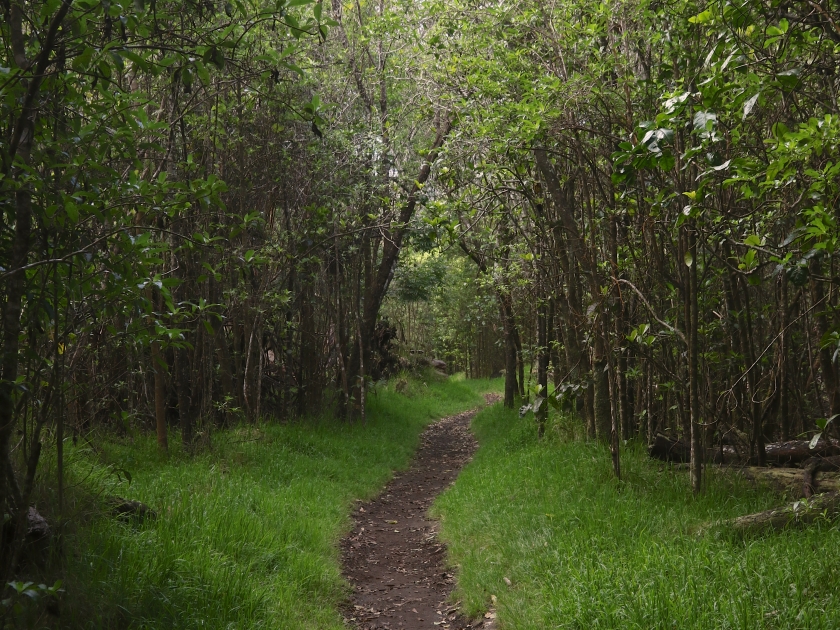Kipuka Puaulu Trail, often called the “Bird Park Trail”, offers a serene escape into Hawaii’s unique biodiversity. This 1.2-mile loop is a haven for birdwatchers, showcasing native species like the ‘apapane and i‘iwi, while also featuring an impressive variety of ancient trees and rare plants. In this guide, we’ll cover everything you need to know about hiking the Kipuka Puaulu Trail.
Highlights
- Kipuka Puaulu Trail is a haven for birdwatchers and nature enthusiasts looking to spot rare Hawaiian species like the ‘i‘iwi or ‘apapane.
- The trail offers a leisurely pace through a unique forest environment.
- Explore a variety of native Hawaiian plants, ferns, and trees, including rare species like koa and ʻōhiʻa.
- This trail is part of a kipuka, an older pocket of vegetation surrounded by younger lava flows, creating a fascinating mix of plants and animals that thrive in this protected environment.
- Away from the more crowded trails in Hawaii Volcanoes National Park, Kipuka Puaulu offers a peaceful and quiet escape into nature.
History

Kipuka Puaulu, located within Hawaii Volcanoes National Park on the Big Island of Hawaii, is a unique ecological area known as a kīpuka. This Hawaiian term refers to a patch of older vegetation that remains intact, surrounded by younger lava flows.
Formation and Survival of Kipuka Puaulu
Millions of years ago, volcanic eruptions from Mauna Loa created vast lava fields across the landscape. However, certain areas were spared from the destructive force of lava, forming kīpukas like Kipuka Puaulu. These isolated pockets became natural sanctuaries for native plants and animals, untouched by the lava’s reach. Over time, the isolation of these kīpukas led to the evolution of unique species, specially adapted to thrive in these environments. The biodiversity within Kipuka Puaulu flourished, turning it into a refuge and hotspot for a variety of Hawaiian species, many of which cannot be found anywhere else.
Designation as a Special Ecological Area
In 1985, recognizing its ecological significance, Kipuka Puaulu was designated as a Special Ecological Area by the National Park Service. This official protection ensures the preservation of its biodiversity by restricting human activity that could disturb the delicate balance of life within the kīpuka. The designation highlights the importance of safeguarding this rare and isolated ecosystem and preserving it for scientific research, education, and future generations.
Trail Development and Visitor Experience
To allow visitors to experience the natural beauty and ecological significance of Kipuka Puaulu, a hiking trail was developed within the kīpuka. This accessible trail meanders through the lush vegetation, offering visitors breathtaking views of the surrounding lava flows and an up-close look at the unique flora and fauna that call this place home. Along the trail, interpretive signs provide insights into the region’s geological and ecological importance, making it an educational experience for nature lovers.
The Biodiversity of Kipuka Puaulu
Kipuka Puaulu is renowned for its extraordinary biodiversity. Home to a variety of native Hawaiian plants and animals, many of which are endangered or threatened, this area offers visitors the rare chance to observe species that have thrived in isolation for centuries. The trail provides educational opportunities to learn about these unique species and their importance within Hawaii’s ecosystem.
Cultural Significance of Kipukas
Beyond its ecological value, Kipuka Puaulu holds deep cultural significance in Hawaiian tradition. Kīpukas are often regarded as sacred spaces, associated with the gods and revered by Native Hawaiians. This cultural connection adds a spiritual layer to the experience of visiting Kipuka Puaulu, offering a glimpse into the relationship between the land and Hawaiian traditions.
Scientific Research and Conservation Efforts
Kipuka Puaulu plays a vital role in scientific research, as scientists continue to study the area’s unique ecosystem to better understand its adaptations. These studies are critical in learning how species within the kīpuka respond to environmental threats such as climate change. The research conducted here not only contributes to the preservation of Hawaii’s biodiversity but also provides valuable insights into global conservation efforts.
At Present
Today, Kipuka Puaulu Trail remains a must-visit destination within Hawaii Volcanoes National Park. It offers an enriching blend of volcanic history, cultural reverence, and ecological diversity that continues to captivate both casual visitors and researchers alike.
Trail Overview
Distance and Difficulty
The Kipuka Puaulu Trail is a 1.2-mile loop with a gentle, well-maintained path, making it an enjoyable and easy hike for all skill levels. The terrain is mostly flat, with slight inclines, allowing hikers to move at a relaxed pace through the diverse landsca
Estimated Hiking Time
Most visitors complete the trail in about 1 to 2 hours, depending on how much time is spent birdwatching or taking in the surroundings. Its short distance makes it perfect for a quick nature walk or a longer, leisurely exploration.
Suitable for All Ages
This family-friendly trail is suitable for all ages, offering a safe and accessible outdoor experience for kids, casual hikers, and even seniors looking to enjoy a peaceful day in nature.
What to Expect on the Trail
Birdwatching Opportunities
Birdwatching enthusiasts will love the Kipuka Puaulu Trail, where native Hawaiian birds like the vibrant ‘apapane, ‘amakihi, and the rare i‘iwi can often be spotted flitting among the trees. These species add both color and sound to the tranquil surroundings.
Plant Life
As you walk the trail, you’ll be surrounded by ancient koa and ohia trees, towering ferns, and a diverse array of native plants. This botanical richness offers a glimpse into Hawaii’s unique ecosystems, making the trail a living natural history museum.
Scenic Beauty
The scenic beauty along the trail is breathtaking, with views of lush greenery set against the backdrop of volcanic landscapes. The contrast between the vibrant plant life and the rugged volcanic terrain creates a peaceful, visually stunning experience for hikers.
Tips for Visiting
- Wear comfortable walking shoes: The trail is easy but can be uneven in spots.
- Dress in layers: The weather in Hawaii Volcanoes National Park can change quickly.
- Bring water and snacks: Stay hydrated and energized, especially if you plan to spend extra time birdwatching.
- Arrive early: Early mornings offer cooler temperatures and better chances to spot birds.
- Respect wildlife: Observe birds and animals from a distance and avoid disturbing them.
- Stay on the trail: Help protect the fragile ecosystem by not wandering off the marked path.
- Pack out your trash: Keep the trail clean and preserve its natural beauty for other visitors.
- Bring a camera or binoculars: Perfect for capturing wildlife and the scenic views along the trail.
Best Time to Visit
The best time to visit Kipuka Puaulu Trail is during the spring and summer months when the wildflowers are in full bloom, adding vibrant colors to the already lush landscape. For the best birdwatching opportunities and to avoid the midday heat, an early morning hike is recommended, as the birds are most active and the temperatures are cooler, providing a more comfortable experience on the trail.
Nearby Attractions

After exploring the Kipuka Puaulu Trail, visitors can enjoy other highlights of Hawaii Volcanoes National Park, such as the fascinating Thurston Lava Tube and the scenic Crater Rim Drive, which offers breathtaking views of the Kilauea caldera. For those looking to unwind, nearby picnic areas and scenic spots provide the perfect setting to relax and enjoy the park’s serene volcanic landscape post-hike.
Frequently Asked Questions (FAQs)
Yes, the Kipuka Puaulu Trail is family-friendly, with its easy terrain and short distance, perfect for hikers of all ages.
Hikers on the Kipuka Puaulu Trail can spot native birds like the ‘Apapane and endemic plant species that thrive in the protected forest.
It typically takes about 1 to 1.5 hours to complete the Kipuka Puaulu Trail, depending on your pace and stops for nature viewing.
Yes, dogs are allowed on the Kipuka Puaulu Trail, but they must be kept on a leash at all times.
Yes, the Kipuka Puaulu Trail is ideal for beginners due to its gentle slopes, short distance, and well-maintained path.
It’s recommended to bring water, sunscreen, and comfortable walking shoes when hiking the Kipuka Puaulu Trail. Binoculars are great for birdwatching!
How to Get There
By Car
To reach Kipuka Puaulu Trail by car, head towards Hawaii Volcanoes National Park located on the Big Island of Hawaii. From Hilo, take Highway 11 south for approximately 30 miles until you reach the park entrance. Once inside the park, continue driving on Crater Rim Drive until you see signs for Mauna Loa Road. Follow Mauna Loa Road for about one mile, and you will find the Kipuka Puaulu Trailhead parking area.
By Bus
If you prefer using public transportation, you can take the Hele-On Bus from Hilo to Volcano Village. This bus route leads you to the entrance of Hawaii Volcanoes National Park. From the bus stop, you can either arrange for a local taxi or rideshare service to take you the remaining distance into the park and to the Kipuka Puaulu Trailhead on Mauna Loa Road, or you can enjoy a scenic walk into the park’s gorgeous surroundings.
Walk Where Birds Sing and Trees Whisper
Kipuka Puaulu Trail offers a peaceful escape into the heart of Hawaii’s natural beauty, where the melodies of native birds and the serenity of ancient trees create a tranquil atmosphere. With its easy terrain and accessibility for all ages, this trail is a must for anyone looking to experience the magic of Hawaii’s wildlife up close. Be sure to add this hidden gem to your Hawaii Volcanoes National Park itinerary for an unforgettable nature walk.




